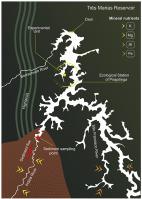当前位置:
X-MOL 学术
›
J. South Am. Earth Sci.
›
论文详情
Our official English website, www.x-mol.net, welcomes your feedback! (Note: you will need to create a separate account there.)
Soil remineralization and recovery of degraded areas: An experience in the tropical region
Journal of South American Earth Sciences ( IF 1.8 ) Pub Date : 2020-11-01 , DOI: 10.1016/j.jsames.2020.103014 Suzi Huff Theodoro , Fernanda de Paula Medeiros , Marco Ianniruberto , Tamiel Khan Baiocchi Jacobson
Journal of South American Earth Sciences ( IF 1.8 ) Pub Date : 2020-11-01 , DOI: 10.1016/j.jsames.2020.103014 Suzi Huff Theodoro , Fernanda de Paula Medeiros , Marco Ianniruberto , Tamiel Khan Baiocchi Jacobson

|
Abstract Many activities related to the expansion of food supply, energy and infrastructure result in great environmental impacts, whose most visible features are observed in the degradation of large areas. The present study demonstrates how the combined use of stonemeal technology and agroforestry systems can help to reverse such impacts, allying the recovery of degraded areas with agricultural and forest production. The study area is located in a hydroelectric reservoir affected by the siltation process and soil erosion in the hydrographic basin of the San Francisco River, Brazil. An Experimental Unit (EU) was set up in the Ecological Station of Pirapitinga (Tres Marias reservoir). The design of the EU was based on a factorial design, with seven treatments applied on six native tree species, with three replications (21 blocks). The germination and establishment data of each species were considered in the different treatments. The oxides concentration and fertility level of sediments were analyzed for the determination of the sampling points in the reservoir. The experiment and evaluation were conducted over six years, and the sediments analysis presented high levels of the essential macronutrients K2O, MgO and TiO2, while CaO and Na2O levels were significantly low, due to their high solubility and mobility. The P2O5 also showed equally low values. After two years, soil pH was balanced, especially in the blocks with mineral inputs. P, K, Ca and Mg concentrations were increased up to 5 times more than those of original soil of the EU, and the highest values were found in the remineralizer + sediment treatment. The use of geological material (e.g. mining waste) and organic compost was proved to be an adequate and sustainable technology to mitigate degradation processes. Besides, locally available sources of organic matter enhanced.
中文翻译:

退化地区的土壤再矿化和恢复:热带地区的经验
摘要 许多与扩大粮食供应、能源和基础设施有关的活动对环境造成了巨大影响,其中最明显的特征是大面积退化。本研究展示了石粉技术和农林业系统的结合使用如何有助于扭转这种影响,将退化地区的恢复与农业和森林生产结合起来。研究区位于巴西旧金山河水文流域受淤积过程和水土流失影响的水电库内。在 Pirapitinga 生态站(Tres Marias 水库)设立了一个实验单位(EU)。EU 的设计基于析因设计,对 6 种本地树种应用了 7 种处理方法,3 次重复(21 个区块)。在不同的处理中考虑了每个物种的发芽和建立数据。分析沉积物的氧化物浓度和肥力水平,以确定水库中的采样点。实验和评估进行了六年多,沉积物分析显示了高水平的必需常量营养素 K2O、MgO 和 TiO2,而 CaO 和 Na2O 的水平显着低,因为它们具有高溶解度和流动性。P2O5 也显示出同样低的值。两年后,土壤 pH 值达到平衡,尤其是在有矿物质输入的区块中。P、K、Ca、Mg 浓度比欧盟原始土壤增加 5 倍以上,在再矿化剂+沉积物处理中发现最高值。使用地质材料(例如 采矿废物)和有机堆肥被证明是一种适当和可持续的技术,可以减轻降解过程。此外,当地可获得的有机物质来源有所增加。
更新日期:2020-11-01
中文翻译:

退化地区的土壤再矿化和恢复:热带地区的经验
摘要 许多与扩大粮食供应、能源和基础设施有关的活动对环境造成了巨大影响,其中最明显的特征是大面积退化。本研究展示了石粉技术和农林业系统的结合使用如何有助于扭转这种影响,将退化地区的恢复与农业和森林生产结合起来。研究区位于巴西旧金山河水文流域受淤积过程和水土流失影响的水电库内。在 Pirapitinga 生态站(Tres Marias 水库)设立了一个实验单位(EU)。EU 的设计基于析因设计,对 6 种本地树种应用了 7 种处理方法,3 次重复(21 个区块)。在不同的处理中考虑了每个物种的发芽和建立数据。分析沉积物的氧化物浓度和肥力水平,以确定水库中的采样点。实验和评估进行了六年多,沉积物分析显示了高水平的必需常量营养素 K2O、MgO 和 TiO2,而 CaO 和 Na2O 的水平显着低,因为它们具有高溶解度和流动性。P2O5 也显示出同样低的值。两年后,土壤 pH 值达到平衡,尤其是在有矿物质输入的区块中。P、K、Ca、Mg 浓度比欧盟原始土壤增加 5 倍以上,在再矿化剂+沉积物处理中发现最高值。使用地质材料(例如 采矿废物)和有机堆肥被证明是一种适当和可持续的技术,可以减轻降解过程。此外,当地可获得的有机物质来源有所增加。



























 京公网安备 11010802027423号
京公网安备 11010802027423号